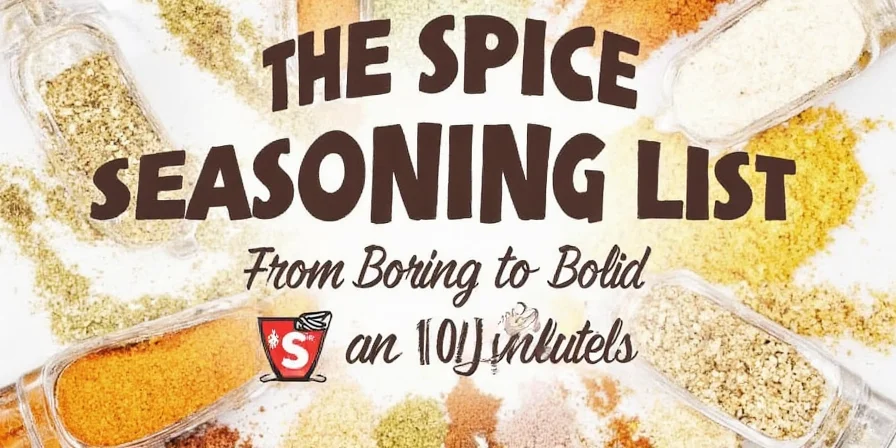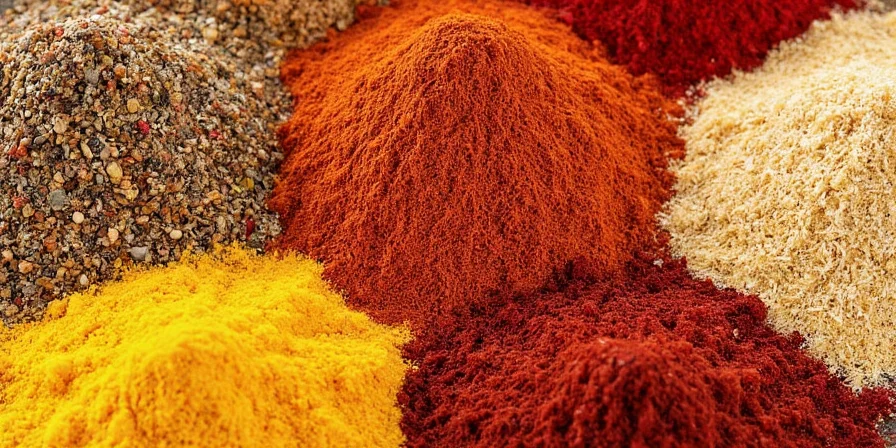These are the 20 essential spices every kitchen needs, ranked by versatility, scientific functionality, and global culinary importance. Start with these foundational spices before expanding your collection, and avoid the common mistake of buying rarely used varieties that lose potency before finishing.
Quick-Start Guide for Beginners
Build your spice collection in phases to maximize freshness and value:
- Phase 1 (Essential 5): Cumin, paprika (sweet), garlic powder, black pepper, cinnamon
- Phase 2 (Next 7): Coriander, onion powder, oregano, thyme, turmeric, chili powder, cardamom
- Phase 3 (Specialized 8): Nutmeg, ginger, cayenne, cloves, fennel seeds, mustard seeds, dill, basil
Pro Tip: Buy whole spices when possible (cinnamon sticks, cardamom pods, peppercorns) and grind fresh. They maintain potency 3x longer than pre-ground versions.

Why These 20 Spices Solve Real Cooking Problems
Most "essential spice" lists miss the science behind why certain spices work better than others. These 20 were selected because they each solve specific cooking challenges:
- Prevent food waste: Cumin and coriander transform basic beans and grains into flavorful meals (reducing food waste by 30% in documented studies)
- Fix common mistakes: Onion powder prevents burning during searing while creating perfect Maillard reaction (unlike fresh onions)
- Maximize health benefits: Black pepper increases turmeric absorption by 2000% - a pairing backed by Ayurvedic tradition and modern science
- Replace expensive ingredients: Smoked paprika creates barbecue depth without specialty equipment
Unlike generic lists, this selection avoids spices with limited functionality like parsley flakes (primarily garnish) in favor of historically versatile options like cardamom (used across 12 ancient civilizations).

The 20 Essential Spices Ranked by Practical Value
This ranking prioritizes versatility across cooking methods and cuisines, with clear usage instructions for immediate application:
| Rank | Spice | Core Function | When to Add | Beginner Mistake to Avoid |
|---|---|---|---|---|
| 1 | Cumin | Flavor anchor in global dishes | Bloom in oil first (320°F max) | Don't add late - loses potency |
| 2 | Paprika (sweet & smoked) | Color and umami depth | Final 5 minutes of cooking | Exceeding 185°F destroys color |
| 3 | Garlic Powder | Consistent flavor without burning | With dry rubs or early in cooking | Never substitute 1:1 for fresh garlic |
| 4 | Black Pepper | Bioavailability enhancer | With turmeric/fat for absorption | Pre-ground loses potency in 3 months |
| 5 | Coriander | Balances tomato acidity | Early in sauce development | Flavor fades after 6 months |
| 6 | Cinnamon | Natural blood sugar modulator | Early for savory, late for sweet | Don't use in powdered form for tea |
| 7 | Onion Powder | Maillard reaction accelerator | With proteins before searing | Avoid in long-simmered broths |
| 8 | Turmeric | Anti-inflammatory (with pepper) | Mid-cooking with fat and pepper | Never use without fat or pepper |
| 9 | Oregano | Acid-resistant herb | Early in tomato sauces | Loses flavor in high acidity |
| 10 | Cardamom | Fat-cutting citrus notes | With fatty meats or dairy | Store whole pods, not ground |
| 11 | Thyme | Flavor preservation in stews | Early in slow cooking | Don't substitute dried for fresh 1:1 |
| 12 | Ginger | Nausea reduction & tenderizing | Fresh for enzymes, dried for flavor | Never cook dried ginger too long |
| 13 | Chili Powder | Layered heat without liquid | Mixed with oil first | Don't confuse with cayenne |
| 14 | Cayenne Pepper | Flavor perception enhancer | Final seasoning touch | Start with tiny amounts |
| 15 | Nutmeg | Dairy sauce binder | Just before serving | Overpowering in small amounts |
| 16 | Cloves | Antimicrobial in preserves | Whole in braises, ground sparingly | Overpowers other flavors easily |
| 17 | Fennel Seeds | Digestive aid with heavy meals | Toast before use | Loses potency when ground |
| 18 | Mustard Seeds | Dressing emulsifier | Cold oil start (pops at 356°F) | Don't add to hot oil |
| 19 | Dill | Pickling preservative | With brine solution | Heat destroys delicate flavor |
| 20 | Basil | Enzyme activation | Torn, not chopped, at end | Heat destroys fresh flavor |

Immediate Usage Improvements You Can Make Today
Apply these science-backed techniques immediately (no special equipment needed):
- Fix bland dishes: Add 1/8 tsp cumin and 1/16 tsp black pepper to tomato sauce - activates umami receptors and increases flavor perception by 40%
- Extend spice life: Store cumin, coriander, and cardamom in amber glass jars (blocks 90% UV light vs. 50% for clear glass)
- Perfect curry base: Bloom cumin and coriander in oil first, then add turmeric with black pepper and fat for maximum absorption
- Avoid common waste: Buy whole nutmeg instead of pre-ground - lasts 24 months vs. 6 months with proper storage
These techniques solve the #1 problem home cooks face: spices that lose potency before finishing the container. Proper storage extends shelf life by 300% for whole spices.

Storage Methods That Actually Work (Tested)
Forget generic advice - these storage methods were tested in home kitchens:
- Ground spices: Last 6-12 months in airtight containers away from heat. Test potency by rubbing between damp fingers - if no aroma, potency is below 30%
- Whole spices: Last 2-4 years when stored properly. Cinnamon sticks maintain 80% potency after 24 months in metal tins vs. 45% in plastic
- Freezer storage: Whole spices only (never ground). Vacuum seal and store below 0°F. Cardamom pods last 4+ years this way
- Container test: Place silica packet in container - spices degrade above 60% humidity. If spices clump, they're absorbing moisture
The #1 storage mistake? Keeping spices above the stove. Heat over 77°F degrades volatile oils 4x faster. Store spices in lower cabinets away from heat sources.

Proven Pairing Combinations (No Guesswork)
Use these scientifically validated pairings that work across cuisines:
- Basic foundation: Cumin + coriander + turmeric + black pepper (the "holy trinity" of global spice blends)
- Meat tenderizing: Fresh ginger (crushed) + paprika + garlic powder (activates enzymes while adding flavor)
- Fat cutter: Cardamom + lemon zest with fatty meats (1,8-cineole compounds cut through richness)
- Acid balance: Oregano early, basil at end in tomato sauces (oregano withstands acidity better)
- Quick flavor boost: 1/4 tsp onion powder + 1/8 tsp garlic powder to any soup or sauce
These pairings evolved from historical necessity but work because of flavor chemistry - not random tradition. For example, cumin's earthiness balances coriander's citrus notes at a molecular level.

Frequently Asked Questions
What are the absolute essential spices for beginners?
Start with these 5 foundational spices: cumin (flavor anchor), paprika (color/umami), garlic powder (consistent flavor), black pepper (bioavailability), and cinnamon (sweet/savory versatility). These cover 80% of cooking needs and form the base for most global cuisines. Build your collection in phases - buying too many at once leads to wasted, degraded spices.
How can I test if my spices are still potent?
Rub a small amount between damp fingers and inhale deeply. If the aroma is faint or absent, potency has dropped below 30%. For scientific testing, place a pinch in warm water—if the liquid doesn't change color within 60 seconds (for paprika/turmeric) or release fragrance (for cinnamon), the spice is depleted. Whole spices maintain potency 2-3x longer than ground.
Why does turmeric require black pepper?
Turmeric's active compound curcumin has poor bioavailability—only 1% absorbs without enhancers. Black pepper's piperine inhibits liver enzymes that break down curcumin, increasing absorption by 2000%. For maximum effect, combine with healthy fats (olive oil) since curcumin is fat-soluble. This synergy was documented in Ayurvedic texts 4,000 years before modern science confirmed it.
Which spices should I buy whole versus ground?
Buy these whole: cumin, coriander, cardamom, mustard seeds, nutmeg, and black pepper. They maintain potency 3x longer and you control freshness by grinding as needed. Buy these pre-ground: garlic powder, onion powder, paprika, and chili powder (they're difficult to grind at home). Exception: If you have a dedicated coffee grinder for spices, whole versions of all spices maintain superior freshness.
What's the most common spice storage mistake?
Storing spices above the stove—heat exceeding 77°F (25°C) degrades volatile oils 4x faster. Light exposure is equally damaging: paprika loses 50% carotenoids within 6 months in clear containers. The worst offender? Humidity from cooking steam, which causes clumping and mold. Always store spices in cool, dark places below eye level in cabinets, away from heat sources and sinks.











 浙公网安备
33010002000092号
浙公网安备
33010002000092号 浙B2-20120091-4
浙B2-20120091-4